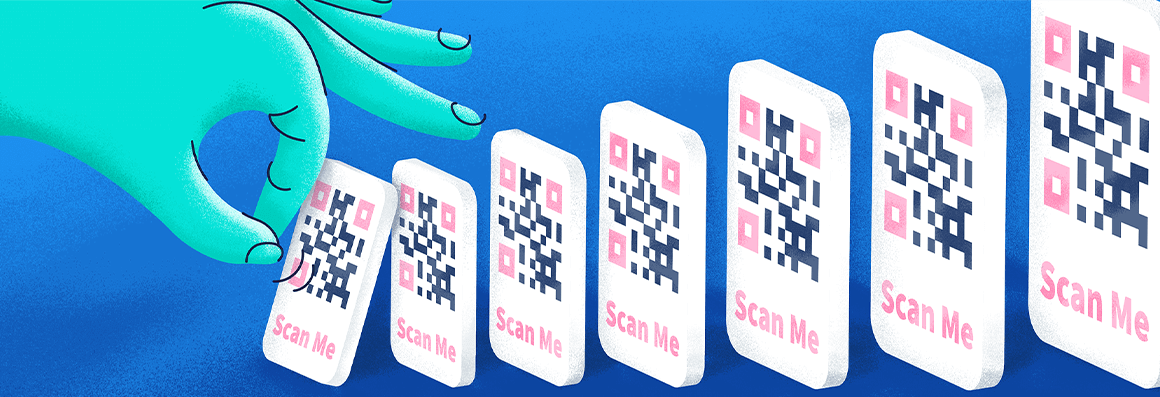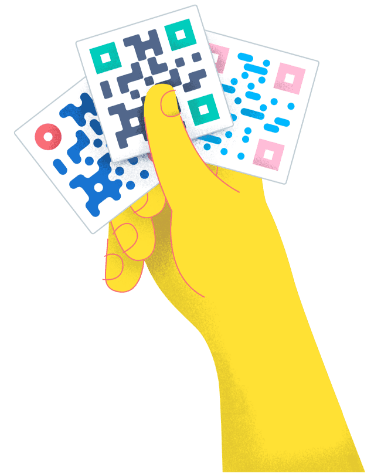- Best Practices ●
- COVID-19 ●
- Industry Trends ●
- Partners ●
- Product ●
How Does a QR Code Encode Data?
Have you ever wondered what’s behind the pixel-like square images known as QR Codes? How can you simply scan it with your smartphone’s camera and access a website, make a payment, or store contact information?
The answer lies in the way QR Codes encode data.
Unlike traditional barcodes, which can only store a limited amount of data, QR Codes use a combination of black and white squares to store data in two dimensions. Due to their innovative design, you can use them for just about anything.
But how exactly does a QR Code encode this data? This guide explains everything you need to know.
QR Code structure
QR Codes can come in almost any shape, but they’re usually square. Why? Because QR Code scanners can easily recognize the standard shape. The square shape also maximizes their ability to store and relay information and reduces QR Code scanning problems.
A QR Code’s puzzle-like appearance contains seven key elements:
- Positioning markings: These are the small squares located at three corners of the QR Code. They allow the camera or scanner to locate the data modules and read the QR Code accurately.
- Alignment markings: Common for larger QR Codes, this element aids with orientation and angle detection to ensure accurate scanning even if the QR Code is tilted or distorted.
- Timing pattern: These are the vertical and horizontal lines that run throughout the QR Code. They tell scanners the size of the data matrix.
- Version information: These sections specify the QR Code version. Out of a total of 40 different QR Code versions, versions 1-7 are the most common.
- Format information: Format patterns include information regarding error tolerance and data mask patterns, making it easier for scanners to read the QR Code.
- Data and error correction keys: This is the actual data. QR Codes use error correction techniques to ensure that scanners can still read the code even if it’s damaged.
- Quiet zone: This is the blank white area around the QR Code. It allows the QR Code reader to distinguish the code from its surrounding materials.
QR Codes vs. barcodes
QR Codes are similar to barcodes, but there is a key difference. Barcodes are one-dimensional, meaning scanners can only read them horizontally. QR Codes, on the other hand, are two-dimensional, so scanners can read them horizontally and vertically.
Left: QR Code Right: Barcode
A big reason why developers created QR Codes was to overcome the data limitations of barcodes. QR Codes can store 4,296 alphanumeric characters, 7,089 numeric characters, or 1,817 Kanji characters—nearly 100 times more data than a traditional barcode.
Why barcodes were developed
The need for barcodes arose in Japan in the 1960s due to the increase in demand for retailers and supermarkets to stock a wider variety of items. Before this technology existed, cashiers had to document all purchases by hand.
As you can imagine, this was a nightmare for staff, so managers set out to find a solution. In the end, stores implemented barcodes to process product purchases via scanning, saving time and costs.
How QR Codes improved on barcodes
While barcodes worked well for decades, companies eventually ran into data limitation issues. Barcodes alone simply couldn’t hold the amount of data that stores needed to manage product inventory. Eventually, store managers contacted a Japanese company called Denso Wave Incorporated to develop a solution.
Despite the pressing need, the company only assigned two team members to the project—one of whom was Masahiro Hara. His ingenious idea was to use a square, two-dimensional image that could hold more information and offer faster scan times. Thus, the QR Code was born.
Now, there is an additional option: RFID microchips. However, when it comes to RFID vs. QR Codes, QR Codes are a more cost-effective, accessible, and practical option for most businesses.
QR Code symbols
QR Code symbols are made up of sections called modules. Each module has a certain size and version number, which ranges from 1 to 40.
Specific symbols are split into data bits stored within the modules and grouped as eight bits each. The reasoning for grouping bits together is it gives the code room for error, meaning a scanner can still read it even if it’s damaged.
QR Code generators also place a mask over the symbols so scanners can distinguish the pattern that makes up the QR Code.
Comparison of data amounts in QR Codes
Top features of modern QR Code technology
QR Codes have boundless use cases thanks to their endless applications across businesses of all sizes and industries. So, what are some of the characteristics that make this data-encoding technology so valuable? We’ll cover just a few features below.
Higher data capacity
The biggest advantage of a QR Code over a barcode is that it can hold literally hundreds of times the information that a barcode can. The key is the square structure that allows for a two-dimensional reading—horizontal and vertical.
Since they hold so much information, you can use QR Codes in all kinds of different ways. QR Code Generator PRO makes it simple to create custom QR Codes that connect to a wide variety of consumer or personal information.
Improved error correction
QR Codes can withstand much more damage than barcodes. Most QR Codes have an error margin of 7–30%, which is extremely important when it comes to inventory management. This means you can print QR Codes to put on product packaging that goes through thousands of miles of manufacturing, assembly, and distribution and is still readable.
Now that many industries have also recognized the total value of QR Codes, the possibilities for their use are basically endless.
Easy to read
QR Codes also require less technical equipment to read. While barcodes require special scanners, QR Codes don’t, as most smartphones now have QR Code readers built in.
For those without built-in QR Code readers, there are plenty of free QR Code scanning apps on the market that allow people to scan QR Codes from their smartphones.
In combination with the popularity of cell phones, this is the element of QR Codes that has brought their use into people’s daily lives across the globe. Some Apple cell phones now even include QR Code scanners directly through the camera. Samsung also offers the same capability on some cell phone models as well.
Using software like Barcode Reader, you can either enter a URL directly or, if you only have the image of the QR Code, it can be uploaded and read. QR Codes, in general, are machine-readable only, so it’s best to find a cell phone and use a scanning app, which can be done with just a quick tap of a button.
Customization features
To describe yet another benefit to QR Codes, they can also be customized and edited after completion (provided you have chosen a Dynamic QR Code). With QR Code Generator PRO’s software, you can create a custom QR Code in just a few seconds that includes individual colors, a logo, and a frame.
There is also a wide variety of information that can be connected to the QR Code itself, making QR Codes a flexible way to enhance marketing campaigns.
Efficient use of space
One of the key strengths of QR Codes is their efficient use of space, and a square can store more data than other shapes within the same perimeter. This is because of its symmetrical properties, which allow for an equal distribution of modules across both horizontal and vertical lines.
Additionally, the square shape allows for more flexibility in terms of the size and placement of modules, making it easier to create a QR Code that is both aesthetically pleasing and functional.
What types of data can a QR Code encode?
To give an overview of just how many ways you can use QR Codes, here are just a few of the different types of QR Codes that you can create with QR Code Generator PRO:
| QR Code Type | Purpose |
| vCard Plus Code | Connect a user to a digital business card |
| Facebook Code | Link to Facebook to gain more followers |
| App Code | Install an app from multiple app stores via one QR Code |
| PDF Code | Add downloadable PDF to any print material |
| Social Media Code | Direct users to multiple social media accounts at once |
| Coupon Code | Display a discount coupon for a product or service |
| Business Code | Advertise your business on an easily readable page |
| Video Code | Share one or multiple videos |
| Rating Code | Collect ratings easily |
| Feedback Code | Share feedback surveys |
| Event Code | Plan and increase attendance for an event |
| Dynamic URL Code | Link to any website, which is changeable at any time |
| Image Gallery Code | View multiple images in one place |
| MP3 Code | Share an audio file in MP3 format |
| Email Code | Collect and share email addresses instantly |
| vCard Code | Share contact details to be added in seconds |
| SMS Code | Send automated messages directly |
| Text Code | Send text in any language and share it |
| Static URL | The standard way to connect a QR Code to any web page |
For a complete list of our QR Code offerings, check out our solutions page!
Pro tip: Use a Dynamic QR Code for marketing campaigns so you can track and monitor scan information. Metrics like location, operating system, total and unique scans, and scans over time are essential when monitoring any marketing campaign that uses QR Codes.
Do damaged QR Codes still work?
In short, yes: QR Codes use an error correction technique called Reed-Solomon coding, which adds redundant data to the code, allowing it to withstand damage and still transmit the correct information. This way, even if a portion of the QR Code is damaged or obscured, the rest of the code can still be read and decoded
This feature is especially useful when considering the various environments in which you can use QR Codes, such as on outdoor advertisements or packaging materials.
Since QR Codes have an indefinite lifespan, this durability ensures the information encoded within them is accessible for as long as needed. This makes QR Codes a cost-effective and reliable option for businesses and individuals looking to incorporate them into their marketing efforts or daily routines.
Explore QR Code technology and start reaping the benefits
Thanks to their data encoding capacities, ease of use, customization options, and durability, QR Codes are a popular tool for businesses and individuals. Whether for marketing campaigns, inventory management, or personal use, QR Codes offer a versatile and cost-effective solution.
QR Code Generator PRO makes it quick and easy to create custom Static or Dynamic QR Codes that you can track, edit, and access. The user-friendly interface, customization features, and in-depth metrics make QR Code Generator PRO an essential tool for anyone looking to start using QR Codes.
So why wait? Explore the benefits of QR Code technology and start using it to your advantage today with QR Code Generator PRO.





